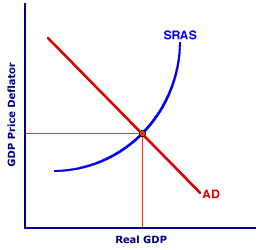
|
|
EXCHANGE RATE: The price of one nation's currency in terms of another nation's currency. This is often called the foreign exchange rate in that it is the price determined in the foreign exchange market when people buy and sell foreign exchange. The exchange rate is specified as the amount of one currency that can be traded per unit of another.
Visit the GLOSS*arama
|
|


|

|
                           EQUILIBRIUM, AGGREGATE MARKET: The state of equilibrium that exists in the aggregate market when real aggregate expenditures are equal to real production with no imbalances to induce changes in the price level or real production. The opposing forces of aggregate demand (the buyers) and aggregate supply (the sellers) exactly offset each other. At the existing price level, the four macroeconomic sectors (household, business, government, and foreign) purchase all of the real production that they seek and producers sell all of the real production that they have. Aggregate market equilibrium is, strictly speaking, equilibrium in the aggregated "product" markets, meaning that there are no economy-wide shortages or surpluses of real production. However, aggregate market equilibrium also involves the aggregate financial and resource markets. As such, aggregate market equilibrium actually comes in two forms: (1) long-run equilibrium, in which all three aggregated markets (product, financial, and resource) are in equilibrium and (2) short-run equilibrium, in which the product and financial markets are in equilibrium, but the resource markets are not. The reason for the difference is short-run price inflexibility that prevents equilibrium in the resource markets.| Short-Run Equilibrium |  | Long-Run Equilibrium |  |
The exhibit to the right can be used to illustrate equilibrium for the aggregate market. The top panel contains a negatively-sloped aggregate demand curve, labeled AD, and a positively-sloped short-run aggregate supply curve, labeled SRAS. The bottom panel also contains a negatively-sloped aggregate demand curve, labeled AD, and a vertical long-run aggregate supply curve, labeled LRAS. In general, aggregate market equilibrium is identified as the intersection of the aggregate demand curve and the aggregate supply curve. However, with two alternative aggregate supply curves, equilibrium also comes in two alternatives--short-run equilibrium and long-run equilibrium. - Short-Run Equilibrium: The first alternative, short-run equilibrium, is the price level and real production obtained at the intersection of the AD and SRAS curves, in the top panel. Short-run equilibrium is based on equilibrium in two of the three aggregated macroeconomics markets--product and financial. However, key to this alternative, resource markets are NOT in equilibrium. Aggregate expenditures exactly match real production, but the quantity of resources demanded need not equal the quantity of resources supplied. Inflexible prices prevent equilibrium in the resource markets.
- Long-Run Equilibrium: The second alternative, long-run equilibrium, is the price level and real production obtained at the intersection of the AD and LRAS curves, in the bottom panel. Long-run equilibrium is based on the simultaneous equilibrium in all three aggregated macroeconomics markets--product, financial, AND resource. Flexible prices ensure equilibrium in all markets.
With both alternatives, aggregate market equilibrium means that there are no economy-wide product market shortages or surpluses. However, this does not necessarily mean that ALL product markets are in equilibrium. A complex economy, like that in the United States, is bound to have shortages in some product markets and surpluses in others, even in long-run equilibrium. As such, prices in some markets rise, while those in other markets fall. These sorts of imbalances in specific markets reflect the ongoing reallocation of resources at the microeconomic level. What is required for aggregate market equilibrium at the macroeconomic level is that the microeconomic shortages and surpluses cancel out, that rising prices cancel falling prices, that the price level and real production do not change.

Recommended Citation:EQUILIBRIUM, AGGREGATE MARKET, AmosWEB Encyclonomic WEB*pedia, http://www.AmosWEB.com, AmosWEB LLC, 2000-2025. [Accessed: July 18, 2025].
Check Out These Related Terms... | | | | | | | | | |
Or For A Little Background... | | | | | | | | | | | | | | |
And For Further Study... | | | | | | | | |
Search Again?
Back to the WEB*pedia
|



|

|
RED AGGRESSERINE
[What's This?]
Today, you are likely to spend a great deal of time at a flea market wanting to buy either a weathervane with a cow on top or a box of multi-colored, plastic paper clips. Be on the lookout for telephone calls from long-lost relatives.
Your Complete Scope
This isn't me! What am I?
|

|
|
In his older years, Andrew Carnegie seldom carried money because he was offended by its sight and touch.
|

|
|
"A winner is someone who recognizes his God-given talents, works his tail off to develop them into skills, and uses those skills to accomplish his goals. " -- Larry Bird, basketball player
|

|
PDV
Present Discounted Value
|

|
|
Tell us what you think about AmosWEB. Like what you see? Have suggestions for improvements? Let us know. Click the User Feedback link.
User Feedback
|


|


